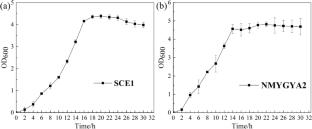Improved hydrolyzed polyacrylamide biodegradation and gel breaking performance of composite bacteria
Abstract
Polymer flooding technology enhances crude oil recovery but generates a large amount of wastewater containing hydrolyzed polyacrylamide (HPAM) and HPAM residue in oil reservoirs, which induce serious environmental problems. Effective degradation of HPAM is highly required in oilfields, especially biodegradation technologies. Ten strains of HPAM degrading bacteria have been screened and identified from oilfield wastewater. An optimal HPAM biodegradation system of composite bacteria has been established based on two strains Agrobacterium pusense NMYGYA2 and Stutzerimonas balearica SCE1. The HPAM biodegradation performance of the composite bacteria has been improved through cultivation condition optimization. The highest HPAM removal rate of 81.2% could be achieved at the optimized condition with the addition of 800 mg·L−1 urea, 500 mg·L−1 glucose and 50 mg·L−1 CaCl2. The gel permeation chromatography results showed that the HPAM molecular weight decreased from 3.7 × 106 Da to 1.9 × 105 Da after the composite bacterial degradation. Fourier transform infrared spectroscopy analysis revealed the hydrolysis of NH2 group and the cleavage of C–C bond. Furthermore, the composite bacteria exhibited the ability to break down HPAM gels via biodegradation at temperatures up to 55 °C, indicating that they can be used to treat the blocking in reservoirs with a temperature < 55 °C and ground facilities.


 求助内容:
求助内容: 应助结果提醒方式:
应助结果提醒方式:


